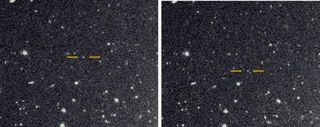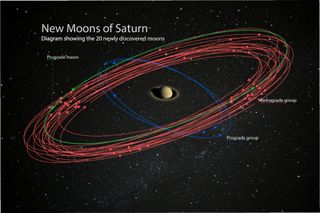Saturn has overtaken Jupiter as the solar system's satellite king.
Astronomers just discovered 20 previously unknown Saturn moons, boosting the ringed planet's tally of known satellites to 82 — three more than Jupiter. And there's more exciting news: You can help name these newfound objects.
All 20 moons are tiny, measuring about 3 miles (5 kilometers) across. Seventeen of them have retrograde orbits, meaning they move around Saturn in the opposite direction to the planet's rotation. These 17 all take more than three Earth years to complete one Saturn lap, and the most far-flung one is the most distant Saturn satellite known, discovery team members said.
Related: Photos: The Rings and Moons of Saturn

One of the three newly discovered "prograde" moons has an orbital period of more than three Earth years, while the other two complete one lap every two years or so.
The 17 retrograde moons appear to belong to the "Norse group" of Saturn satellites, which share the same basic orbital parameters. The two innermost prograde objects align with the "Inuit group," and the outermost prograde moon among the new finds may belong to the "Gallic group," but that's unclear at the moment, researchers said.
Each of these satellite groups is likely evidence of a long-ago impact that destroyed a larger moon that had been orbiting in that general area.
Get the Space.com Newsletter
Breaking space news, the latest updates on rocket launches, skywatching events and more!
"This kind of grouping of outer moons is also seen around Jupiter, indicating violent collisions occurred between moons in the Saturnian system or with outside objects such as passing asteroids or comets," Scott Sheppard, of the Carnegie Institution for Science in Washington, D.C., said in a statement today (Oct. 7) announcing the discovery.

Sheppard led the discovery team. He and his colleagues — David Jewitt of the University of California, Los Angeles, and Jan Kleyna of the University of Hawaii — found the Saturn moons using the Subaru Telescope in Hawaii.
"Using some of the largest telescopes in the world, we are now completing the inventory of small moons around the giant planets," Sheppard added. "They play a crucial role in helping us determine how our solar system's planets formed and evolved."
For example, the newfound moons' existence suggests that the impacts that created them occurred after Saturn was fully formed, Sheppard said. The gas giant was surrounded by a disk of dust and gas as it was taking shape. If these tiny moons had to plow through all that material on their way around Saturn, friction would have sapped their speed and sent them spiraling into the planet.
Sheppard discovered a dozen Jupiter moons last year, and the Carnegie Institution organized a public contest to name five of those worlds. If you missed that competition, don't worry: You now have another chance.
"I was so thrilled with the amount of public engagement over the Jupiter moon-naming contest that we've decided to do another one to name these newly discovered Saturnian moons," Sheppard said. "This time, the moons must be named after giants from Norse, Gallic or Inuit mythology."
All 20 newfound Saturn moons are fair game for naming. If you're interested, submit your proposal by tweeting @SaturnLunacy from now until Dec. 6. Include your reasoning and the hashtag #NameSaturnsMoons.
"Photos, artwork and videos are strongly encouraged," organizers wrote on naming-contest page here, which has lots more information.
Visit Carnegie Science's Saturn Moon Name Contest page for more contest details.
- Inside Gas Giant Saturn (Infographic)
- Saturn's Moon Titan May Have 'Phantom Lakes' and Caves
- In Photos: Cassini Mission Ends with Epic Dive into Saturn
Mike Wall's book about the search for alien life, "Out There" (Grand Central Publishing, 2018; illustrated by Karl Tate), is out now. Follow him on Twitter @michaeldwall. Follow us on Twitter @Spacedotcom or Facebook.

Join our Space Forums to keep talking space on the latest missions, night sky and more! And if you have a news tip, correction or comment, let us know at: community@space.com.

Michael Wall is a Senior Space Writer with Space.com and joined the team in 2010. He primarily covers exoplanets, spaceflight and military space, but has been known to dabble in the space art beat. His book about the search for alien life, "Out There," was published on Nov. 13, 2018. Before becoming a science writer, Michael worked as a herpetologist and wildlife biologist. He has a Ph.D. in evolutionary biology from the University of Sydney, Australia, a bachelor's degree from the University of Arizona, and a graduate certificate in science writing from the University of California, Santa Cruz. To find out what his latest project is, you can follow Michael on Twitter.
